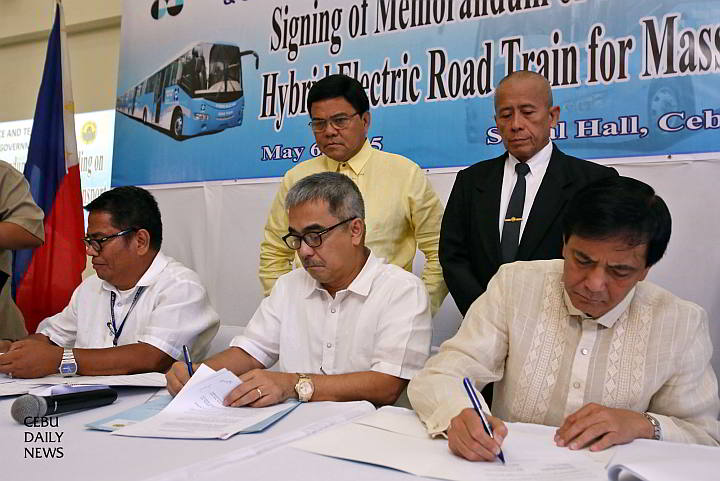Route may go farther to Mactan airport; DOST signs agreement with Cebu City gov’t

Science and Technology Secretary Mario G. Montejo (seated, center) with Cebu City Michael Rama and DOST Regional Director Edilberto Paradela (left) sign an agreement for a Hybrid Electric Road Train for Mass Transport. The ceremony in Cebu City Hall was witnessed by Cebu City Vice Mayor Edgardo Labella and Councilor Bob Cabarrubias, standing behind them.
(CDN PHOTO/JUNJIE MENDOZA)
Metro Cebu may see a hybrid electric road train running in its streets by next year.
Under an agreement signed yesterday with the Department of Science and Technology (DOST), routes will be identified for use of its prototype transport train which looks like buses linked to one another, running on electric power and diesel fuel.
No cables or metal tracks are needed.
“Hopefully we can start implementing this in Cebu City by early next year. We will have the light version of the hybrid electric road train in Cebu City because the roads here are narrower, said Dr. Rio Pagtalunan, project leader from the DOST.
Made by Filipino engineers, the system runs on diesel fuel and an electric-powered battery making it both energy-efficient and low-pollution.
What routes will it ply? Cebu city is the core, but the plan may extend to Metro Cebu.
Rafael Yap, executive director of the Cebu City Traffic Operations Management (Citom), said they are looking at P. del Rosario Street in Cebu City going to Mandaue City all the way to the Mactan Cebu International Airport in Lapu-Lapu City.
He said they are studying areas that will not be serviced by the Bus Rapid Transit (BRT), which is scheduled to operate in Cebu city after 2016, and SM’s proposed bus system for the South Road Properties.
A light version of the bus-like train is set for a performance test in Clark Field in Pampanga by July or August this year. Then it will be demonstrated in Cebu City.
Cebu City Mayor Michael Rama welcomed the signing of the agreement with Science and Technology Secretary Mario Montejo.
Rama recalled telling President Aquino before that he didn’t want a massive, concrete infrastructure like the Metro Rail Transit (MRT) or Light Rail Transit (LRT) systems in Cebu City.
DOST will identify possible Cebu-based fabricators or manufacturers to build the road train and conduct a feasibility study of a road train system including a viable route network, fare system and transport passenger flow.
Cebu city will identify possible routes and assist in the expropriation of lots that may be affected by the electric road train’s route.
DOST has been testing the Hybrid Electric Road Train in Pampanga and in the UP Campus in Diliman, Quezon City.
The smaller version for Cebu will be 30 meters long. It will still have five coaches linked to one another. One is for the driver, while the other four coaches can each accommodate 40-45 passengers.
The original model of the road train is 40 meters long with five coaches.
With each coach carrying 65 passengers, the entire road train can accommodate 260 passengers.
The speed for the original model reaches 50 kilometers per hour.
“But based on our initial tests, it can run up to 69 kph and can make a turning radius of 15 meters,” Pagtalunan said.
The DOST developed this as an alternative means of transportation to answer the mass transportation dilemma in metro roads.
“The train is designed to be energy-efficient, which means it does not need electricity and suspended cables to operate. This newest Filipino innovation also produces less carbon emission compared with existing mass transport vehicles, making it an eco-friendly mode of transport,” said a DOST statement.
Science and Technology Secretary Montejo said they are excited to implement the project in Cebu City.
In the proposed set-up, he said DOST will provide the technology, a private manufacturer can replicate the model and the project can be implemented under a Public-Private Partnership scheme.
Asked about cost, he said the road train would cost five to ten percent more than the regular air-conditioned buses.
“But it has the advantage of being 20 to 25 percent more energy efficient,” he said.